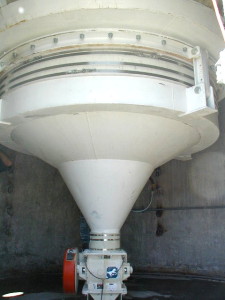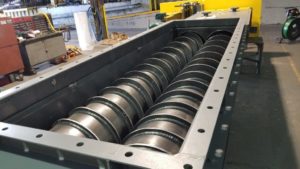Loading Spouts
A loading spout is used to contain fugitive dust when loading a truck, railcar, barge or ship. Loading spouts can also be used for charging material onto a storage pile. The design of a dustless loading spout incorporates the use of a dust collector, whether venting to the top of the silo using the dust collector fan, or using an integral dust collector built into the loading spout system. A telescoping chute directs the material through a series of cylinders to contain the dust but does not incorporate dust collection. For large loading systems, using a specifically designed chute that cascades the material back and forth in the downspout to control the flow of material and to mitigate any dust generation.
Slide Gates
There are several types of shut off Gates available to control or stop the flow of dry bulk solids. A rolling slide gate is a blade that is manually or automatically actuated to slide on slide rails or roller wheels to pass through the flow to shut off the material flow. These gates can be designed to cut through a solid column of material by incorporating a displacement pocket at the sealing end of gate travel allowing the material a place to go. These gates can be provided with packing gland seals and full dust enclosures to minimize any dust escaping the system.
A rollerblade gate is another technology available to control and shut off the flow of a dry bulk solid. A roller blade gate incorporates a curved blade that rotates through the flow and then cams forward into the seal at the end of the stroke. This cam action avoids wear on the seal during the opening and closing of the rollerblade. This rollerblade action can also be used to meter material onto belt conveyors, as well as on large systems, used to control the flow for railcar loadout systems.
Transloading
Moving material from a railcar into a truck can be done with a stationary system using mechanical conveying equipment in a pit, such as screw conveyor, belt conveyor or drag conveyor. The horizontal conveyor in the pit will discharge into an elevating conveyor such as a bucket elevator, vertical screw conveyor or inclined belt conveyor. When a pit arrangement is not desirable or available, a high incline portable belt conveyor is a great solution. This unit maneuvers under the discharge of the railcar above the tracks, allows the railcar to discharge into the inlet of the belt conveyor, and then conveys the material up a high incline (60°) and discharges into the truck. These machines can be smaller electric versions or can be diesel powered with total self-sufficiency.
Scaling Systems
When loading trucks or railcars, a scale is required to certify the weight of the truck or car for trade. Truck or railcar scales can be provided underneath the loading system or in a separate area of the track to verify the material amount. Another way to accomplish this is to use a bulk loadout scale which uses a net weigh principle to measure discrete loads in a scaling hopper, and then discharging them into the truck or railcar.
Vibrating Bin Discharger

Most loadout systems utilize silos or bins to accumulate material so the truck orrailcar can be loaded instantaneously. When a material sits in a silo for any length of time, it may need encouragement to discharge out of the silo. A vibrating bin discharger utilizes a motor with eccentric weights to energize the bottom section of a hopper which is hung from isolation mounts. Typically between 1/3 and 2/3 of the diameter of the silo is covered with this discharging device to input energy into the material to break up bridges and to allow the material to freely flow through the system.
Mass Flow Feeders
 Particle segregation is important for some processes. Incorporating a mass flow feeder into the bottom hopper of a storage silo or bin provides a way to allow the material to discharge uniformly across the cross-section of the silo. An example of a mass flow feeder would be a series of parallel screw conveyors that cover 1/3 to 2/3 of the bin and incorporates a steep walled transition from the silo diameter down to the opening of the mass flow feeder. The feeding screws on a mass flow feeder would also incorporate a progressive pitch in order to pull material uniformly across the length of the inlet area. This feeder would then discharge into a common conveyor that would then discharge into the process.
Particle segregation is important for some processes. Incorporating a mass flow feeder into the bottom hopper of a storage silo or bin provides a way to allow the material to discharge uniformly across the cross-section of the silo. An example of a mass flow feeder would be a series of parallel screw conveyors that cover 1/3 to 2/3 of the bin and incorporates a steep walled transition from the silo diameter down to the opening of the mass flow feeder. The feeding screws on a mass flow feeder would also incorporate a progressive pitch in order to pull material uniformly across the length of the inlet area. This feeder would then discharge into a common conveyor that would then discharge into the process.